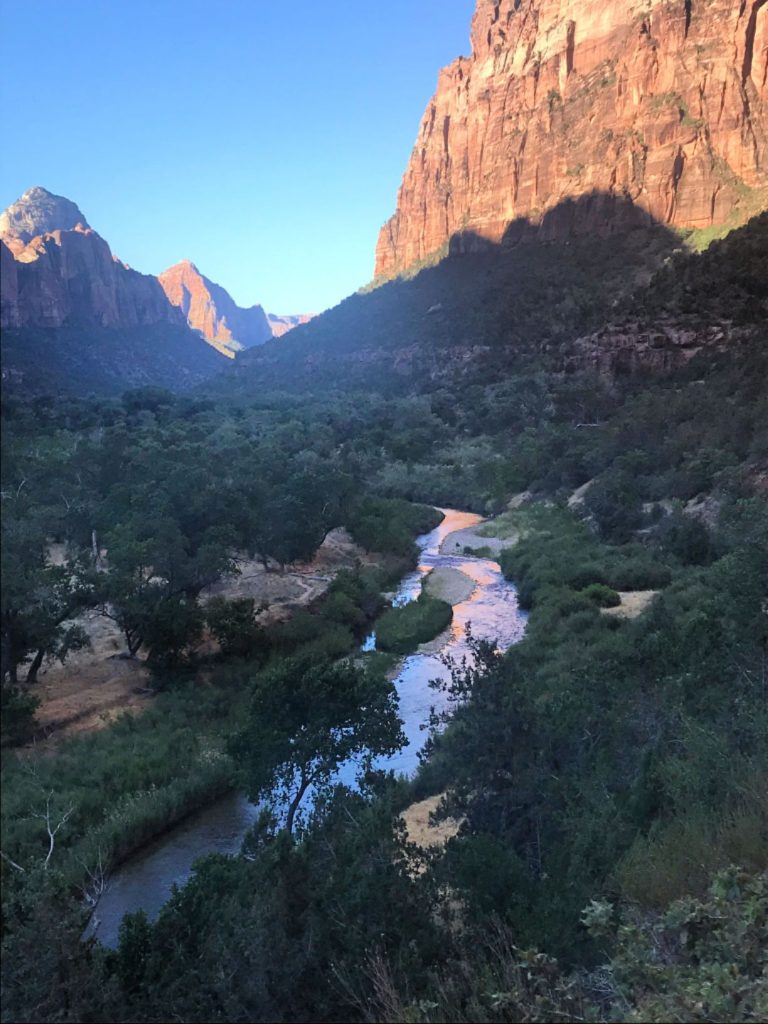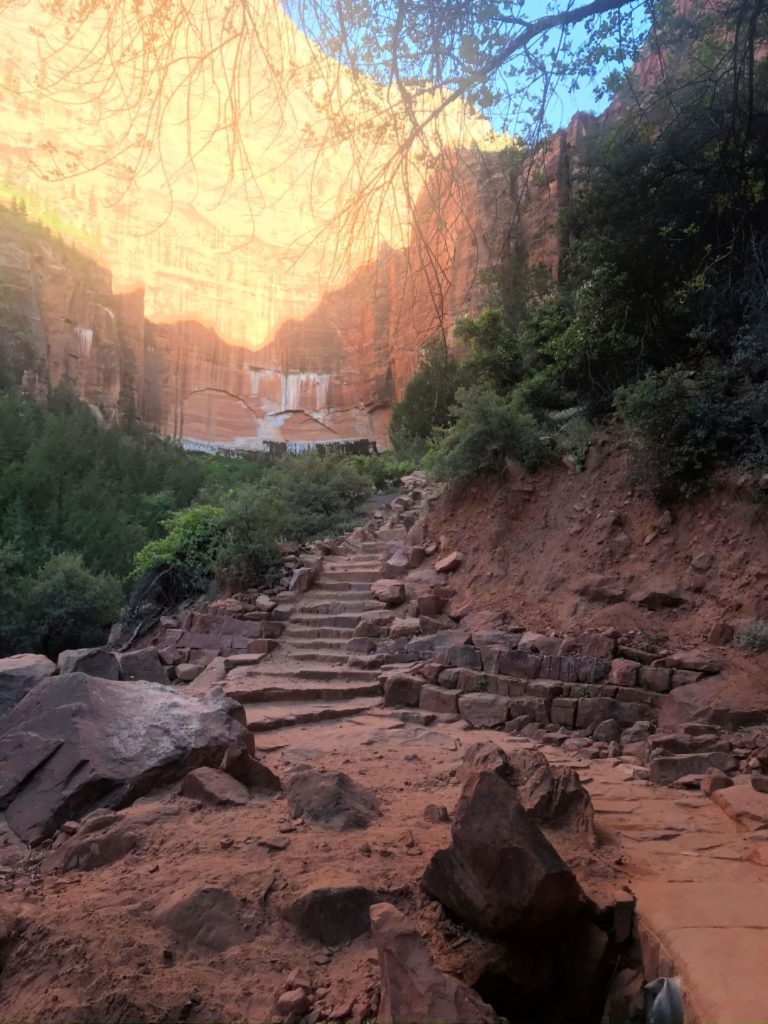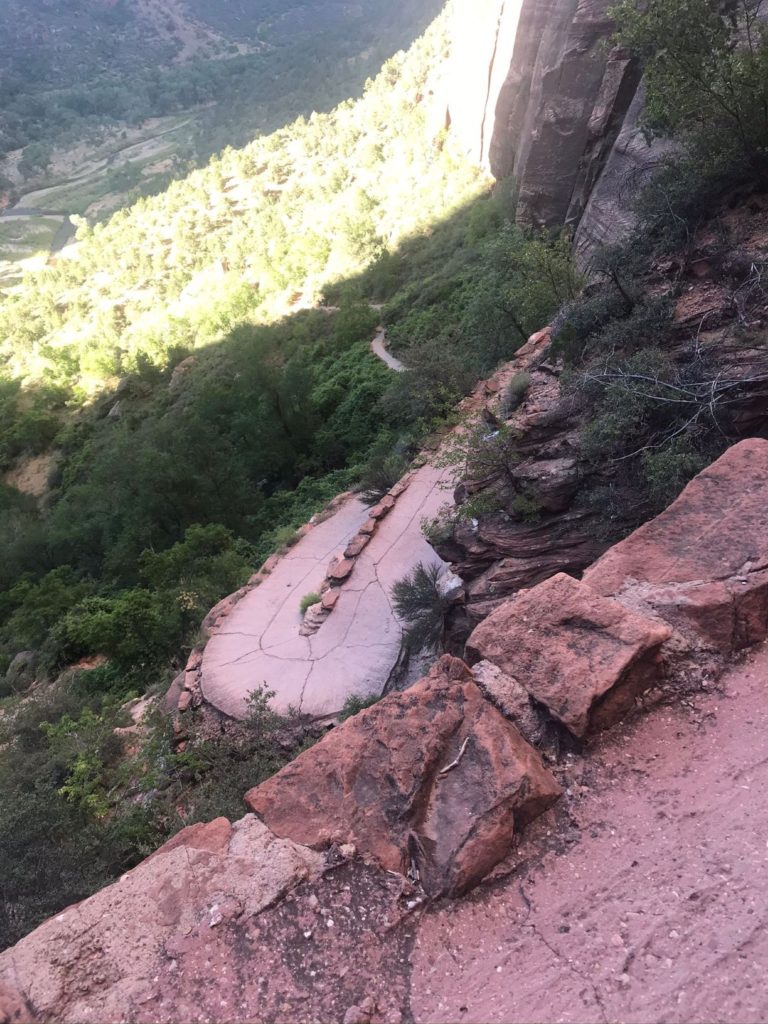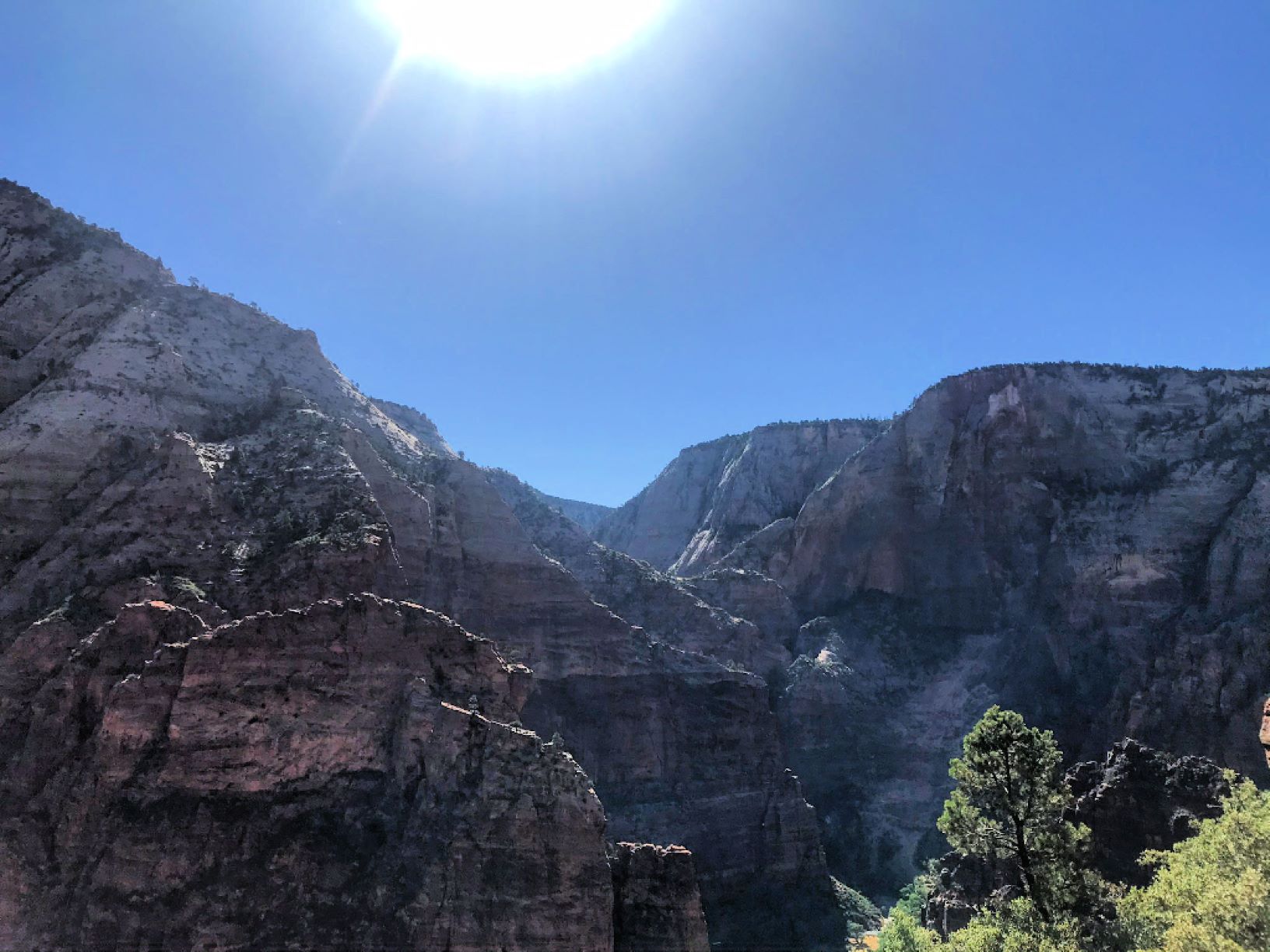My husband and I recently visited Zion National Park and had an awesome time. Since I didn’t know much at all about this park before our trip, I thought I’d share some answers to commonly asked questions. Hopefully, this will help you in your planning if you ever decide to visit yourself.

Planning a trip now? Make sure to scroll down to the bottom for some easy steps and recommendations for planning your travel.
Where is Zion National Park?
This post contains affiliate links, and I may earn a commission when you click the links at no additional cost to you. This helps pay for my blog.
Zion National Park is in the southwestern section of Utah on the very edge of the Colorado Plateau. The park is actually a large nature preserve known for Zion Canyon’s steep red cliffs. Zion Canyon Scenic Drive cuts through the park’s main section, leading to lots of winding forest trails along the Virgin River. If you have never been, it is worth adding to your must-see list.
Part of what makes Zion National Park so beautiful is the contrast of the lush, green high country, and the dry desert below. It is a part of the so-called “Grand Circle Tour”, a series of three spectacular national parks: Bryce Canyon National Park, the Grand Canyon, and Zion National Park. The tapestry of vast desert views, tree-covered valleys, and colorful canyons makes viewing this park a very unique experience. Eighty-four percent of Zion’s 124,000 acres of extraordinary landscapes are still preserved as untouched wilderness.
What is so special about Zion National Park?
Zion is Utah’s first national park. This is where you can walk along the same paths as ancient native people and pioneers traveled. The main highlight of Zion National Park is an enormous canyon. It is amazing to look up at massive red and pink sandstone cliffs all around you with a backdrop of a beautiful deep blue sky.

Averaging 2,000 feet deep, Zion Canyon offers lots of opportunities for hiking along its floor. One of the most famous hikes is in the 20 to 30-foot wide area known as The Narrows, where hikers have to walk in the water to pass through the “narrow” opening between two huge cliffs.
The Virgin River flows to what is called the Emerald Pools, which have small waterfalls and a pretty hanging garden. Other beautiful features of Zion include the many natural rock arches.

Filled with a plethora of geological works of art, soaring rock pinnacles, magnificent arches, and beautiful rainbow-colored rocks, Zion National Park is one of the best places in the world for sightseeing. The natural wonders of deep orange and red-colored sandstone formations, crystal-clear streams, and canyons will blow you away. There is even a canyon wall that is called the Weeping Canyon because the constant dripping water makes it look like it is crying.
Zion is known throughout the world as one of the best places for canyoneering, the extreme sport of descending slender canyons. Some of the most famous canyons in Zion include Subway, Zion Narrows, Mystery Canyon, Pine Creek, Orderville Canyon, and Keyhole Canyon. Needless to say, I did not participate in canyoneering. The uphill hikes were extreme enough for me.
Why is Zion Called Zion?
The first Anglo-European settlers, Mormon pioneers, arrived in this southwestern area of Utah in the late 1800s. They named the area Zion, which is ancient Hebrew for sanctuary or refuge. In 1918 Munkutuweap National Monument became Zion National Monument and in 1919 the name changed again to Zion National Park. Now you know.
When is the Best Time to Visit Zion?
We went in July, and it was ridiculously hot. Spring and fall might be better times to visit since the weather is more moderate during these seasons. April and May and September and October are usually warm and sunny with highs between 60 and 90 degrees on average. However, it can also get pretty cool and rainy at times during these months.
Zion National Park is open all year, but the majority of visitors come in summer and early fall. In spring (March-May), the spring thaw creates magnificent seasonal waterfalls in the main canyon, but some of the most popular attractions are closed due to the Virgin River’s spring runoff. From June on, all sections of the park should be open, but due to the summer tourist season, from mid-May to mid-September, you could end up in large crowds. Make sure you check the park website regularly for COVID-19 updates as well.
Many say that the best time to go to Zion National Park is the second half of September. The weather is still hot, the days are typically clear, and the rivers are warm. Also, the leaves begin to change some in September, creating some spectacular views. Early November is not bad either. In October and November, the temperatures are said to be the most pleasant, and if you are particularly lucky, you may even witness the first snow in Zion. That would be cool – literally!

Is it Free to Visit Zion National Park?
There is a fee of $35 per car to enter the park. This will buy you a pass for a week (7 consecutive days). Just keep it in the glove compartment of your car and show it to the person at the gate when you return. Note: parking is very limited, so arriving early is recommended. The park can get crowded.
How Does the Park Shuttle Work?
Driving through Zion National Park can be beautiful, but if it is your first time to visit you will probably get the most out of your trip by taking the free shuttle bus, which is located in the town of Springdale. During the tourist season, large sections of the park are closed off for private vehicles. The shuttle will take you on a Zion scenic drive up the main canyon, accompanied by an audio introduction pointing out what to see in Zion National Park.
There are actually two shuttle lines. In addition to the free shuttle bus outside of the park, the other one is inside the park. You have to purchase a ticket in advance from recreation.gov in order to ride this shuttle (because of COVID-19). It runs from the Visitor Center up the Scenic Drive to places like the Zion Lodge and to different trailheads, including Emerald Pools, Scout’s Lookout, and Temple of Sinawava where hikers depart for the Narrows. The shuttle makes multiple designated stops at trailheads and scenic viewpoints. You can get a Zion National Park Information Sheet from the Visitor Center and take it with you. Then you can get off the bus often to take in the scenery or hike. It is very convenient.
Make sure to check the park website for COVID-19 updates. When we went in July there was limited seating on the shuttles, and the tickets sold out fast. The tickets are for certain time periods only. The first day we did not arrive in time to catch our shuttle at the designated time, so we could only hike outside of the park. The second day we were so glad we had made the smart decision to book a 6:00 am time slot for our ticket. As mentioned earlier it was crazy hot in July, so we were able to beat the crowds and beat the heat. We got all of our hiking in during the cooler morning hours and were so glad we did!
Parking is limited, and you can only park in a designated area. Riding the free shuttle in from town will keep you from having to worry about finding a legal parking place.
Can I Drive Through Zion National Park?
You can only drive through Zion Canyon in your own car a few months out of the year, but you can drive the Mount Carmel Highway at any time. Mount Carmel Highway is a 12-mile highway that connects the south and east entrances of Zion National Park, and driving it is an amazing experience! It eventually meets up with US 89. We came in this way through the east entrance, and it was a beautiful way to introduce us to this unique national park. The road goes through a super long tunnel built right into the cliffs. Pretty cool!
How Far is the Drive to Zion From Las Vegas?
Zion National Park is located 160 miles (2.5-hour-drive) from Las Vegas. Most of the drive to the park is along Interstate 15, which has some interesting sights and attractions along the way. Take your time and enjoy the drive!
How Far is Zion From the Grand Canyon?
Zion National Park is located just two hours north of the Grand Canyon North Rim. The park is 30 miles in length and fifteen miles across at its widest point.
Where Should I Stop Between Zion and Las Vegas?
We did not make it there on our trip, but I suggest Snow Canyon State Park if you have some extra time. The park is about 128 miles from Las Vegas and is filled with beautiful geographical features, interesting plants, and a rich history like petroglyphs, which is a form of rock art.
How Many Days Do You Need in Zion?
It has been suggested that you plan at least 5-7 days for your trip to Zion National Park, but you can still enjoy the highlights in much less time. One day was plenty for us. If you’re an avid hiker, you might want to take your time visiting popular (and strenuous) day hikes such as Angels Landing, Zion Narrows Day Hike, and Observation Point Trail. But make sure to pack plenty of water and snacks before you set out. There is really no convenient place to get food inside the park once you are on the trails.
Best Ways to Spend One Day in Zion National Park
What if you only have one day to visit Zion National Park? That is all that we had. No worries!
Here is a Perfect One Day Itinerary for Zion National Park:
You can start your day off at the Zion National Park Visitor Center to see which attractions are open and safe to explore. Sometimes certain areas are closed or considered too dangerous because of things like rockfalls or flash floods. Unfortunately for us, the visitor center was closed when we were there. Make sure you read all of the COVID-19 updates on the park website before you go.
Another option if you are there super early is to begin with the sunrise at Canyon Overlook.

The Visitor Center has a handy information sheet with a detailed hiking guide describing each hike and letting you know how strenuous each activity is. Once you get all the information you need, it will be easier to decide what to do in Zion National Park. Even though the visitor center was closed for us, park rangers were always available to help.
Next, you can visit the Zion Human History Museum which is one of the first stops on the shuttle route through Zion National Park. It is mainly a cultural museum with exhibits focusing on the history of the American Indians, early settlers and pioneers, as well as initial conservation efforts which led to the establishment of Zion National Park in 1919. This museum used to be the visitor center before the 1990s. You can enjoy breathtaking views of the Bridge Mountain Arch and the Altar of Sacrifice as well.
After visiting the museum, make a short stop at the Court of the Patriarchs Viewpoint, which is a group of three adjacent, similar cliffs named after the biblical patriarchs Abraham, Isaac, and Jacob. The path to reach the viewpoint is super short, so you won’t lose a lot of time making this stop and the view is worth it. There is also a path that leads to the Sand Bench Trail across the road, but you might want to save that for a unique Zion horseback riding experience.
You can take a lunch break at Zion Lodge if you want, or you can bring your own lunch in a backpack as we did. Zion Lodge, built in the 1920s, is a rustic, medium-sized hotel. It is a member of Historic Hotels of America, as part of the National Trust for Historic Preservation. Keep in mind that Zion Lodge is one of the major stops for the shuttle, so there will be lots of people getting on and off.
You can choose one of several on-site restaurants for lunch. You can also visit the gift shop then sit down and rest under the enormous cottonwood tree in the middle of the grand lawn. If you brought your lunch this might be a good picnic spot.
If I ever go back, I’d like to go horseback riding on the trails in Zion. Across the road from Zion Lodge, you will find the horse stables maintained by Canyon Trail Rides for Zion horseback riding on the Sand Bench Trail. This is actually a commercial horse trail, open between March and October.
From what I have read, this trail runs across the middle of an awe-inspiring landslide under The Sentinel peak, one of the most prominent features of Zion National Park. The landslide is actually a huge section of The Sentinel that broke off and slid down thousands of years ago.
I wish I had known about this when we were there because several have said this is one of the best things to do in Zion National Park, this trail is not as popular as some of Zion’s other attractions, so it is less crowded. Instead of practically killing ourselves hiking uphill in unbearable heat, we could have had an unforgettable experience on horseback in the middle of Zion’s most unique scenery. Aren’t you glad I told you about this? You can check out their official website for more information.
After your horseback ride, get back on the shuttle and head for Weeping Rock. This stop brings you to the starting point for several hikes including Deertrap Mountain, Hidden Canyon, Cable Mountain, East Rim Trail, and Observation Point. Weeping Rock is a famous landmark, because the constant springs dripping from above make it look as if the rock is crying. The phenomenon happens because the lower layers of sandstone have eroded away, and the water going down gets pushed out the side after reaching a solid rock layer. A short, but steep hike will get you there in ten minutes or less.
Now for hiking! There is no way to see everything in one day, so you will have to choose one of the three very strenuous hikes. Some of Zion’s most famous attractions take hours of hiking to reach, so if you’re only spending one day there you want to make sure you don’t miss your shuttle back by trying to do too much. You definitely don’t want to get caught there after dark! Also, if you go in July as we did you can flip your day around and do your hiking in the cooler morning hours. Consider your physical fitness and the information in your visitor center packet, and choose the one attraction that is best suited for you.

First Hiking Option: The Narrows
The Zion Narrows is one of the most famous day hikes in the park. We saw parts of it but did not do the hike. The Temple of Sinawava is the last shuttle stop, after which you will notice the walls of the canyon start closing in around the Virgin River. The river water cuts its way through the narrow, deep sandstone labyrinth. We saw the entrance where people were entering the very narrow passageway and saw how the smart ones were wearing water shoes with their hiking shoes tied to their backpacks. The trail actually goes through the river! A walking stick is a good idea to help you stay steady walking through the current. You can even swim in some places!

Second Hiking Option: Observation Point
Observation Point is said to be one of the most famous viewpoints in Zion. However, in order to get to this spectacular view you will have a very challenging 4-mile hike from the Weeping Rock Trailhead. Completing the trail can take anywhere from 4 to 6 hours, but they say that when you finally get to the top, you will be glad you did it.
Third Hiking Option: Angel’s Landing
This is the option we chose, although I think if we had known how difficult it was going to be we might have chickened out. We just naively dove right in, and by the time we realized we might have bitten off more than we could chew we were already halfway there. We figured, “We’ve come this far it would be a shame to turn around now!” We also did a less strenuous hike to the Emerald Pools.

Angel’s Landing is one of the classic landmarks in Zion National Park. Just about any travel guide you read will name a hike to the top as one of the most memorable things to do in the park. Let me tell you, if you are afraid of heights I would not attempt this hike. The path of steep rocky switchbacks is bordered by long drop-offs, and only a steep narrow ridge leads to the summit.

To get to the very top a chain was recently installed for people to hold on to for balance (Since 2004, ten people have died from falling while hiking this trail). However, when we were there that section was closed. The chain was too much of a high touch area, so because of COVID-19 health and safety guidelines, this section was closed.
The view at the top was spectacular, along with the sense of pride and accomplishment (and disbelief) that we felt for dragging our 50-something-year-old bodies up two and a half miles of a 1,500 feet elevation uphill climb all the way. I kept thinking, “This better be making me skinny!”

There are guided hiking tours by experts if you’d prefer not to try to navigate the trails on your own. The Zion Adventure Company is one well-known group that provides several options for tours.
As you’re leaving the park, take the time to stop and explore Springdale, a small tourist town named one of the 20 prettiest towns in the U.S. by Forbes magazine. Originally a Mormon farming community, Springdale is now filled with art galleries, quaint little hotels, coffee shops, and restaurants.

EXTRA TIPS FOR VISITING ZION
Make sure to park legally during your stay in Zion National Park. The parking space is limited and parking is only allowed in designated stalls. If you break the rules, your vehicle may get towed. In case all of the designated stalls in Zion are full, you can park in Springdale and take the free shuttle to Zion National Park.
If you are staying at one of the campgrounds, make sure to make reservations at least three months in advance.
There have been accidents involving casualties in Angels Landing, The Narrows, and The Tunnel. Always be careful and prepared.
Bring a pair of really good shoes. The soles should be hard and grippy. We wished we had hiking boots because our running shoes did not have great support for walking on rocks.
For longer hikes, bring some food and water with you.
Leave no trace. When hiking, you should stay on the trail, and don’t remove anything from the park. Carry out what you carry in. Don’t leave any trash behind!

Are There Dangerous Animals in Zion National Park?
Bears, mountain lions, and rattlesnakes are the most dangerous inhabitants of Zion National Park, but they are rarely seen. There are no bison or wolves roaming around, but there is a large amount of wildlife that calls the landscape home. Common to the park is the ringtail cat, though most park visitors are not familiar with it. I had never even heard of it.
Believe it or not, the most dangerous animal in Utah is the moose. Moose have only inhabited Utah for about 100 years, but they’ve multiplied rapidly. The Shiras moose (also called the Wyoming moose) might look kind of clumsy and goofy, but you shouldn’t underestimate him.
My husband really scolded me for getting so close to the moose in the park, but a car kept trying to drive in the parking lot. I was in the way and could only get out of their way by stepping closer to the moose. So do what I say not what I did. Stay far away from the moose!
Where Should I Stay When Visiting Zion National Park?
Here are some resources that will help you plan your trip. If you click through my links you will be able to access the best and most current prices and deals. These are companies that I trust and I think will be the most helpful to you as you plan.
Book a Flight
If you are not within close driving distance to your destination you will need to book a flight. I don’t know if you have heard of this company yet, but with Skyscanner you can find cheap flights anywhere in the world. The website is super easy to use, and if you use my link above you will be able to compare flights and prices and have a seat booked without all the hassle of multiple website searches. Skyscanner is awesome!
Book a Room
Hotels.com has great deals on National Park lodging. They are very reliable. If you want to see tons of reviews on places to stay, TripAdvisor has over 150 million reviews and opinions of hotels, restaurants, attractions, and more by travelers like you and me.
Book a Car
You could go through individual rental car companies if you want, but if you check out TripAdvisor they have great comparisons. Also, if you book hotel and rental car together it is oftentimes cheaper.
Luggage
If you are needing new luggage for your trip check out some really awesome deals on good quality luggage at Chester Travels.
Travel Insurance
One of the worst things is to be out of town and have something bad happen. Accidents, unexpected mishaps, and other troubles can and do happen. But if you are prepared you can have peace of mind. That’s why getting travel insurance is a great idea. And it does not cost that much. Travel insurance can help you deal with theft, health issues, and other troubles. I recommend World Nomads. The people at World Nomads are passionate travelers themselves, so they know what can happen. The link above will take you to their very best deals.
Most of all, have fun!
Please leave a comment below. What was your favorite National Park to visit?

